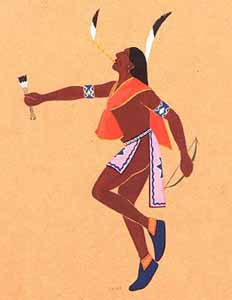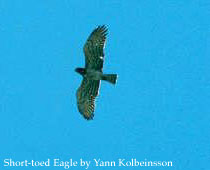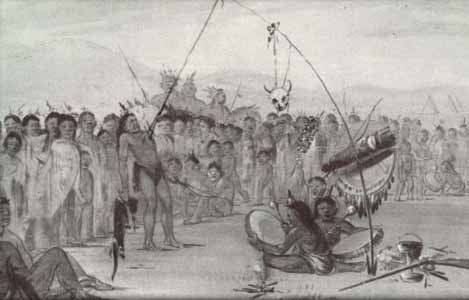
The Sun Dance, one event that meant the most to the Plains Indians. That ceremony was the most important religious ritual to those people at that time. Many tribes performed the sun dance, some were the Arapoho, Cheyenne, Sioux and Ogala. The Plains Indians weren't the only ones to perform this, Some of the Great Basin tribes also had the Sun Dance as part of their lives. Of course there were many others. The ceremony came into view around the 19th century to the plains of North America. The dance was a 4-8 day event most often performed in the summer around the time of the Summer Solstice. Before the the ceremony could take place preparations were done to make the dance. During the dance many of their beliefs would come out into the air. Symbolism and the rituals performed within the dance were very important. Those decided the man's future. "The floats as wild breezes leaving every beauty free, To sink, or well, as Heaven pleases." - George Catlin

This is a Man Performing in the Sun Dance

This event was a very elaborate and tedious ceremony performed, so many things had to be done before it could start. The Sun Dance was different for a lot of the tribes. The outside of the dance, all the big rituals, were the same, however all the sacred items within the ceremony varied from one tribe to another. This happened because all the tribes had different beliefs and things they considered sacred. Another thing that differed from tribe to tribe was the way the Sun Dance came to them. Each Tribe had their own myths on the subject. Some tribes believed it was given to them by their God, Wakan Tanka as a way to make peace. Some others thought it happened through a journey. They thought that at one point in time a man from their tribe went away and brought back with him the Sun Dance. As you can see the Sun Dance was very different and meant something different to many people of the Plains Indians. The way it came to the Plains Indians wasn't the only thing different, the views and beliefs on the Sun Dance also varied. Each tribes view on the ceremony and what it meant in some cases determined what would go on during the dance. To the Cheyenne the Sun Dance meant world renewal and peace for all, so in their tribes many of the things they did would have to do with restoring nature. As in many tribes the Cheyenne also had another name for the Sun Dance they would also call it "Oxheheom." One meaning of the Sun Dance was shared within many tribes. Many thought it was a rebirth of their people and would keep their spirit alive.
Many preparations that had to be done before the ceremony could begin took much time. Many things that had to be done were the making of the sacred items that would be used in the dance. Another way they would prepare was through their spirit talking to their God. In the Ogala tribe the candidate for the Sun Dance had to make and offering to the sun and during the actual dance they had to make a wound on themselves that would have continuously drip blood. "The common earth, the air the skies, To her were opening paradise." - George Catlin. The things that had to be done to make the surroundings and actually allow the ceremony to take place were very important and scared. In the Lakota tribe the center pole would have to be from a cottonwood tree. The tree was usually chosen through song and prayer. Maidens who would be lead by the eldest woman of the camp would then go and strip the tree free from its branches. When the tree was being cut down and almost finished the final cut would have to be made by the virgin woman. To this tribe the tee is so sacred it must not touch the ground until it reaches the spot where it shall stay for the rest of the ceremony. One of the most time consuming preparations was the making of the Sun Dance lodge, one of the key elements in the ceremony. "I should explain to you here that in setting up the Sun Dance lodge, we are really making the universe in a likeness; for, you see each of the posts around the lodge represents some particular object of creation, so that the whole circle is the entire creation, and the one tree at the center, upon which the twenty-eight poles rest is Wakan Tanka, who is the center of everything. Everything comes from Him, and sooner or later everything returns to Him." - Black Elk. After the last of the preparation was finished the Sun Dance would then begin, on the last day, at sunset.
When the dance began all of the tribe would gather to watch the man go through to God. The dance was ran by the oldest, most respected holy men, but the ceremony was headed by the maker also known as the priest. The sun-pole would be used for many different things. During the dance the men would dance around it and use it for self sacrifice. To some tribes the Wakan Tanka (God), would most respect the men and the sun-pole if the sun-pole had a fork at the top with offerings. In the hole below where the pole is placed would be offerings such as tobacco, buffalo fat, and other sacred items. At the top of the pole would be sixteen cherry sticks all to represent the thunderbird. "The center tree is the staff of life, and on it are these medicines and the representatives of the Maker of All Things. It is through the Center Pole that we meet God, so we must go to the center of the circle and understand the responsibility of being placed at the center of the creation." - Chief of the Crow, Thomas Yellowtail.

This is the eagle which was a very symbolic measure.
Symbolism
One of the most important parts of the ceremony was the Symbolism. The members of the dance would do many things of symbolic measurement for God. Before the ritual the members would have their grandfathers paint symbolic writings on them. The eagle during the ritual would fly high over them leading the tribe to believe that the eagle was connecting then to Wakan Tanka. The men would sometimes make dress as animals such as grizzly bears, eagles, snakes, wolves, and many other animals. The men would then make the noise of their creature they were dressed as. The Buffalo Dance was a dance used often in the ceremony, it represented blessings of home and human fertility. After the act of self mutilation was done the men would be decorated with symbols of how they suffered at the end of that ritual. On the last day of the Sun Dance all men who participated would then have their ears pierced to show that they have made offerings to God through the Sun Dance. As you know symbolism is a main ingredient to the dance and one of the main symbolic measures is the buffalo. The buffalo was thought to be the source of life to the Indians so of course it meant a lot to them. "The buffalo represents the people and the universe and should always be treated with respect, for was he not here before two-legged peoples, and is he not generous in that he gives us our homes and our food? The buffalo is wise in many tribes, and thus we should learn from him and should always be as relative with him." -Brown 1967. Some tribes would stuff a buffalo's head so that it would look alive, and then would place its head on the fork of the center tree. To the Cheyenne all sacred items must be related to the buffalo. The buffalo was also a major part in the members visions. "Dancers challenge his [the buffalo's] attention by 'running at it,' suffering and praying that the buffalo person will take notice and 'run over them,' bringing a dancer what he desires, and perhaps something more the gift of a power to cure." -Vogel 1984. Buffalo wasn't the only sign of symbolism. Medicine Bundles held fun, feathers, and and eagle's head and claw. In the Crow tribe the men's shields must show symbolic figures of their faith. Of course the eagle thought to deliver prayers to their God shows how important it was. "Prosperity wealth follow the eagle who may bestow the gift curing." -Vogel 1984. So as you see without the symbolism the meaning would have been forgotten.
Rituals
The rituals that went on in the dance were there to show what type of man the candidate was. The main event was the Ritual were hooks were attached to the skin and the man danced until he broke free. This may have taken hours. One reason why self sacrifice, took place was because of the buffalo. To the men the buffalo was kind to them giving them shelter, food, and many other useful things they needed to survive, so this was the way the men gave themselves back. The men would fast, thirst, and self- inflict pain to give back to nature. The scars made were respected, they are honorable signs of insignia. Some of the ritual dances performed were very gruesome. The certain dance picked by the man would determine how much respect he was given. There were many different ones to choose from, but here were some of the most popular.
Gazing-At-The-Sun ~ This ritual required you to look at the sun from dawn till dusk. This ritual was a piece of cake compared to the other more grueling ones, but it was usually performed by the younger men who this was their first time participating in the Sun Dance.
Pierced ~ This was one of the rituals that caused self - sacrifice. The man would have a hook attached to his chest and and would be held from the center pole. The man would have to dance or any other act to break free from the hook.
Suspended ~ In this one the man would be pierced on the upper chest and upper back. Then another man would get on all fours on the ground and the member participating in this ritual would step on his back. The man on the ground would then remove himself leaving the participant hanging from to hooks a four poles. The man would have to hang there until the hooks tore from his skin.
Dragging of Buffalo Skulls ~ The upper back would be pierced and and a rope would hang from a skewer attached to the rope. Then a buffalo skull would be tied to the end. The man would then have to dance or drag the buffalo skull around until it pulled the hook out. This was one of the most respected acts because it was one that caused most pain and also had a symbolic measure from the buffalo.
"The truth of the oneness of all things we understand a little better by participating in the rite, and by offering ourselves as a sacrifice." -Brown 1967. After the whole entire dance was completed all sacred items would be left with the dance lodge for nature to do with as it pleases.

This is the "Pierced" ritual done in the Sun Dance
Unfortunately nature has not had much to do with lately. The United States Government banned the Sun Dance in 1904. Today tribes still perform some elements from the Sun Dance and are trying to fully regain it.

Laura Grace
8th American History
Rossville Jr. High
Plains History Project
2004